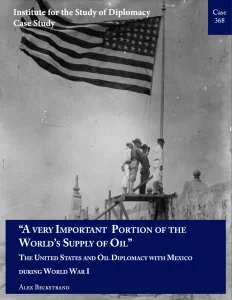
This case study examines U.S. oil diplomacy with Mexico between 1917-1918. This period immediately followed an American invasion of northern Mexico in 1916 in pursuit of bandits led by Francisco “Pancho” Villa. Over ten thousand U.S. troops were in Mexico, resulting in multiple clashes with the Mexican government and dozens killed on each side. The United States withdrew forces in early 1917 following a major war scare that saw the U.S. mobilize over 100,000 troops along its southern border, including the entire National Guard. Tensions remained high even following the withdrawal of forces.
The case study also examines American threats of force, another tool used by the Woodrow Wilson Administration. Although the President made it clear to his cabinet that conflict with Mexico was off the table, the government signaled to its southern neighbor its willingness to use force to occupy oil fields and protect American lives and interests. This provides an opportunity to discuss with students the validity of the “military option.” At the same time, while threatening Mexico with invasion, President Wilson himself was clear that he would not militarily engage Mexico while simultaneously fighting in Europe.
In the end, this case study demonstrates that the Wilson Administration’s approach, while flawed and at times distasteful, helped ensure access to Mexico’s growing oil output during a time of crisis. The key element was the use of multiple means toward the same goal, a lesson still applicable today.